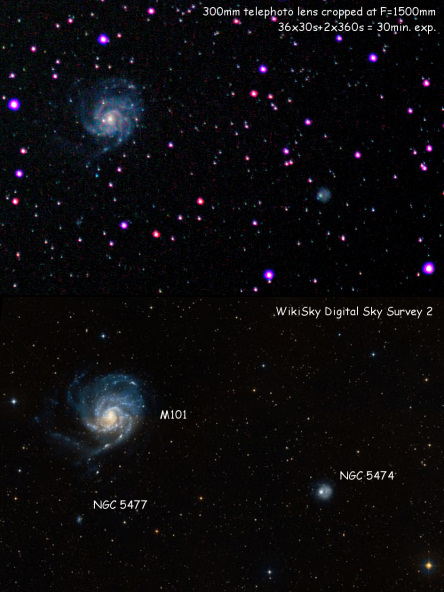M101 with 300mm telephoto lens
This is a crop of the resulting stacking of 36x30s + 2x360s subframes taken this month in two different sessions. The area showed corresponds to M101 and surroundings (in Ursa Major), in which we find other 2 galaxies NGC 5474 and NGC 5477. Below, I have added a DSS2 image of the are for comparison. My stars are blobs, meanwhile DSS2 are pinpoint. On the other hand, I use to lose star colours specially in the brightest ones , when postprocessing and stretching histogram. Maybe some day I will learn how to fix all these errors …

2010/04/26 at 7:04 am
Still a lovely outcome I’d say 🙂
Btw, if you have the time it would be really nice to have a tutorial on how to stack photos and so on ( you know, for newbies astrophotographers) 🙂
I enjoy reading your blog and seeing your photos, I think they are a very refreshing view from the huge res photos I see from special cameras and so on and furthermore it shows me that I can do stuff like this as well 🙂
Thank you for taking the time and sharing this 🙂
Have a great day.
2010/04/26 at 11:04 am
Thanks for your comments. Here you have a nice tutorial:
http://www.astro.shoregalaxy.com/dslr_astro.htm
Clear skies!
2010/04/29 at 12:26 pm
Thank you very much for the tutorial, I’ll have a look. Thus far I’ve only been able to take a kind of a blurry image of the Moon through my binoculars. However, what is one blurry shot for some, for me is a work of art hehe 🙂
2010/05/08 at 5:53 am
In regards to the shot of the Clavius Crater taken April 12,2009.
I have a Meade LX200 12″. I have been all over this area with my Meade and never have noticed or seen this object before. If this object is still there, what is needed with my Meade telescope in order to get as much resolution of this same object? Does this object seem to come and go, or is it a perminate fixture to the landscape? As I have seen atlases of the Moon, the pictures taken by NASA, never shows this structure, I wonder why?
2010/05/08 at 10:00 am
Clavius crater is always there, but it may be located in the shadow or in the light. That depends on the lunar phase. With your 12″ telescope, you should observe this crater with great detail. Try to locate it in the southern region of the Moon.